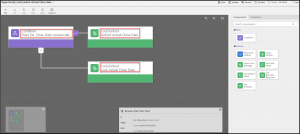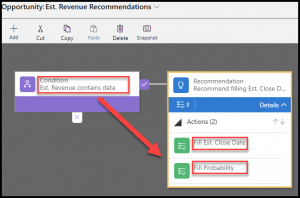Business Rules in Dynamics 365 CRM: How Do They Compare to Dynamics Workflows and Microsoft Flow?
With numerous options to implement business logic in Microsoft Dynamics for Customer Engagement (CRM), Business rules are an oft-overlooked component with real-time capabilities that can be very helpful. While Dynamics 365 Workflows and Microsoft Flow each have their own uses in CRM, Business Rules’ in Dynamics 365 for Customer Engagement are easy to understand and can offer user-friendly features that limit the custom development that used to be required to do this functionality.
Aside from Business Rules, there are two native processes compared to Dynamics 365 (D365) Workflows, and Microsoft Flow (Flow)—each has its use. Enough though Business Rules can be very effective in CRM, their functionality is limited. It is important to clarify how each of these tools can be used in CRM.
D365 Workflows
Workflows built inside of CRM can be very helpful when the process happens exclusively inside of CRM. The option to choose between real-time and background for the workflows enables you to choose between functionality and system performance, and, unlike Business Rules, can be activated off nearly any event in CRM. While it is helpful to see the results of a process in real-time, it can also degrade the speed of CRM, so Business Rules can be used in place of some real-time workflows to help with performance.
Additionally, email notifications cannot be sent from CRM through Business Rules, so workflows can be used to send internal emails. For example, if an opportunity has not received activity in a month, then a D365 Workflow may send an email to the associated sales rep in order to check in with that contact This email can also include a dynamic hyperlink to the opportunity record, which streamlines the process for the sales rep receiving the notifications triggered by the workflow.
Microsoft Flow
Flow can also be triggered by D365 events; however, Flow is capable of much more than D365 Workflows. Flow is an external tool that connects Dynamics to SharePoint, OneNote, and other Microsoft services in addition to third-party resources including Gmail, Google Drive, and Slack. This functionality enables Flow to create actions and connect applications in ways the Business Rules and D365 Workflows cannot do. Keep in mind that, much like real-time workflows, this can slow down the system as well.
There are numerous other tasks that Flow can do, including record deletion and creation functions, push and text notifications, and creating workflows that span multiple applications. Between D365 workflows and Flow, there are seemingly endless processes that can be created across CRM and between CRM and other applications, but there is a performance-friendly option to implement business logic in CRM in Business Rules.
Business Rules
Business rules often act in real-time and have a variety of functions. Each of the functions will be explored below to explain how they can be used to improve CRM for your business. The below screenshot shows the interface for creating business rules.
Lock/Unlock
The Lock/Unlock Business Rule enables the user to lock or unlock a field dependent on whether another field on the form contains certain data. If the system requires the user to enter Est. Close Date data before Actual Close Date data you may want to use a Business Rule to lock the latter field based on one whether the former contains data, as seen above.
Set Default Value
Setting the default value will place a value in a field based on meeting the condition in the Business Rule. In the recommendation below, there are two Set Default Value Business Rules. A value can be a formula, which can add or subtract from the original field, add days (if it is a date field), or it can set an arbitrary value or the value of another field.
Set Visibility
Setting the visibility is a common function that I like to use with business rules. It allows you to streamline the data that is seen by a user when on a form. In one project I worked on recently, I used the show visibility rule based on whether a box was checked yes or no. If yes was selected, then the other fields would show, but if no was selected, they would stay hidden. This rule and Lock/Unlock can be used in place of each other depending on what you want users to see when on a form.
Recommendation
The recommendation tool does not fill in, lock, or even require another action; however, it can be useful when entering data into CRM, among other uses. On an Opportunity form, when a salesperson enters data in the Est. Revenue field, which is not a required field, there may be a recommendation to put data in the Estimated Close Date and Probability, which can create a weighted pipeline as mentioned above, and allow sales managers to keep track of opportunities with greater detail. Below, you can see that when the Est. Revenue field contains data, then two recommendations to set the field value are given for each the Est. Close Date field and the Probability field.
Other business rules include showing an error message, setting a field value, and setting a field as business required. As detailed above, Business Rules have plenty of potential for business use. Business rules are at their best when you need quick actions done on a form, which they do very well. Business Rules can provide quick, code-less business logic to maintain system performance and are great tools to guide end-users in CRM.
If you have any questions about Dynamics 365 for Customer Engagement reach out to the team at Stoneridge Software.
Under the terms of this license, you are authorized to share and redistribute the content across various mediums, subject to adherence to the specified conditions: you must provide proper attribution to Stoneridge as the original creator in a manner that does not imply their endorsement of your use, the material is to be utilized solely for non-commercial purposes, and alterations, modifications, or derivative works based on the original material are strictly prohibited.
Responsibility rests with the licensee to ensure that their use of the material does not violate any other rights.


